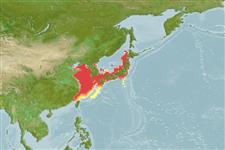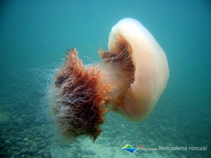Nemopilema nomurai Kishinouye, 1922
Nomura's jellyfish| Native range | All suitable habitat | Point map | Year 2050 |

|
| This map was computer-generated and has not yet been reviewed. |
| Nemopilema nomurai AquaMaps Data sources: GBIF OBIS |
Classification / Names Common names | Synonyms | CoL | ITIS | WoRMS
Scyphozoa | Rhizostomeae | Rhizostomatidae
Environment: milieu / climate zone / depth range / distribution range Ecology
Pelagic; depth range 0 - 176 m (Ref. 122799). Subtropical; 52°N - 29°N, 117°E - 142°E (Ref. 121705)
Distribution Countries | FAO areas | Ecosystems | Occurrences | Introductions
Northwest Pacific: endemic to the East Asian Marginal Seas.
Length at first maturity / Size / Weight / Age
Maturity: Lm ? range ? - ? cm Max length : 200 cm WD male/unsexed; (Ref. 99323); max. published weight: 200.0 kg (Ref. 3010); max. reported age: 1.00 years (Ref. 100320)
Life cycle and mating behavior Maturity | Reproduction | Spawning | Eggs | Fecundity | Larvae
Main reference
References | Coordinator | Collaborators
Kawahara, M., S.-I. Uye, K. Ohtsu and H. Iizumi 2006 Unusual population explosion of the giant jellyfish Nemopilema nomurai (Scyphozoa: Rhizostomeae). Mar. Ecol. Prog. Ser. 307:161-173. (Ref. 3004)
IUCN Red List Status
(Ref. 130435: Version 2025-1)
CITES status (Ref. 108899)
CMS (Ref. 116361)
Threat to humans
Human uses
Fisheries: commercial
| FishSource |
Tools
More information
Max. ages / sizes
Length-weight rel.
Length-length rel.
Length-frequencies
Mass conversion
Abundance
Internet sources
BHL | BOLD Systems | CISTI | DiscoverLife | FAO(Publication : search) | Fishipedia | GenBank (genome, nucleotide) | GloBI | Gomexsi | Google Books | Google Scholar | Google | PubMed | Tree of Life | Wikipedia (Go, Search) | Zoological Record



